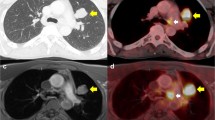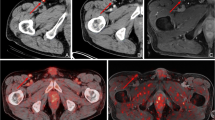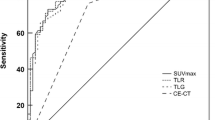Abstract
Background
The aims of this prospective study were to determine the diagnostic value of 18F-fluorodeoxyglucose positron emission tomography/computed tomography (FDG PET/CT) and brain MRI in melanoma patients with palpable lymph node metastases and to assess the impact of these imaging modalities on their management.
Materials and Methods
Between October 2006 and March 2009, PET/CT and brain MRI were performed in 70 melanoma patients with palpable nodal lymph node metastases and without evidence of systemic dissemination after physical examination. Hypermetabolic PET/CT lesions were examined by histology or cytology or were imaged further and followed if no pathology confirmation could be obtained.
Results
PET/CT findings changed the intended regional node dissection in 26 patients (37%). PET/CT was false negative in 4 patients (6%) and false positive in 1 (1%). This resulted in a sensitivity of 87%, specificity of 98%, accuracy of 93%, positive predictive value of 96%, and negative predictive value of 91%. MRI revealed brain metastases in 5 patients (7%). The overall survival of patients without additional lesions on PET/CT was 84% after 2 years, which was better than the 56% in patients with additional metastases (P < .001).
Conclusions
PET/CT has an 87% sensitivity and 98% specificity in the detection of other metastases in melanoma patients with palpable lymph node involvement. PET/CT leads to a change in the planned regional node dissection in 37% of the patients in this study. MRI revealed brain metastases in 5 patients (7%). PET/CT findings correlate with survival.




Similar content being viewed by others
References
Balch CM, Soong SJ, Gershenwald JE, Thompson JF, Reintgen DS, Cascinelli N, et al. Prognostic factors analysis of 17,600 melanoma patients: validation of the American Joint Committee on Cancer melanoma staging system. J Clin Oncol. 2001;19:3622–34.
Hughes TM, A’Hern RP, Thomas JM. Prognosis and surgical management of patients with palpable inguinal lymph node metastases from melanoma. Br J Surg. 2000;87:892–901.
Reintgen DS, Cox C, Slingluff CL, Jr., Seigler HF. Recurrent malignant melanoma: the identification of prognostic factors to predict survival. Ann Plast Surg. 1992;28:45–9.
Soong SJ, Harrison RA, McCarthy WH, Urist MM, Balch CM. Factors affecting survival following local, regional, or distant recurrence from localized melanoma. J Surg Oncol. 1998;67:228–33.
Mijnhout GS, Hoekstra OS, van Tulder MW, Teule GJ, Deville WL. Systematic review of the diagnostic accuracy of (18)F-fluorodeoxyglucose positron emission tomography in melanoma patients. Cancer. 2001;91:1530–42.
Fink AM, Holle-Robatsch S, Herzog N, Mirzaei S, Rappersberger K, Lilgenau N, et al. Positron emission tomography is not useful in detecting metastasis in the sentinel lymph node in patients with primary malignant melanoma stage I and II. Melanoma Res. 2004;14:141–5.
Wagner JD, Schauwecker D, Davidson D, Logan T, Coleman JJ 3rd, Hutchins G, et al. Inefficacy of F-18 fluorodeoxy-D-glucose-positron emission tomography scans for initial evaluation in early-stage cutaneous melanoma. Cancer. 2005;104:570–9.
Friedman KP, Wahl RL. Clinical use of positron emission tomography in the management of cutaneous melanoma. Semin Nucl Med. 2004;34:242–53.
Ho Shon IA, Chung DK, Saw RP, Thompson JF. Guidelines for imaging in cutaneous melanoma. Nucl Med Commun. 2008;29:877–9.
Antoch G, Saoudi N, Kuehl H, Dahmen G, Mueller SP, Beyer T, et al. Accuracy of whole-body dual-modality fluorine-18-2-fluoro-2-deoxy-D-glucose positron emission tomography and computed tomography (FDG-PET/CT) for tumor staging in solid tumors: comparison with CT and PET. J Clin Oncol. 2004;22:4357–68.
Pelosi E, Messa C, Sironi S, Picchio M, Landoni C, Bettinardi V, et al. Value of integrated PET/CT for lesion localisation in cancer patients: a comparative study. Eur J Nucl Med Mol Imaging. 2004;31:932–9.
Reinhardt MJ, Joe AY, Jaeger U, Huber A, Matthies A, Bucerius J, et al. Diagnostic performance of whole body dual modality 18F-FDG PET/CT imaging for N- and M-staging of malignant melanoma: experience with 250 consecutive patients. J Clin Oncol. 2006;24:1178–87.
Krug B, Crott R, Lonneux M, Baurain JF, Pirson AS, Vander Borght T. Role of PET in the initial staging of cutaneous malignant melanoma: systematic review. Radiology. 2008;249:836–44.
Kitajima K, Nakamoto Y, Okizuka H, Onishi Y, Senda M, Suganuma N, et al. Accuracy of whole-body FDG-PET/CT for detecting brain metastases from non-central nervous system tumors. Ann Nucl Med. 2008;22:595–602.
Rohren EM, Provenzale JM, Barboriak DP, Coleman RE. Screening for cerebral metastases with FDG PET in patients undergoing whole-body staging of non-central nervous system malignancy. Radiology. 2003;226:181–7.
Bastiaannet E, Oyen WJ, Meijer S, Hoekstra OS, Wobbes T, Jager PL, et al. Impact of [18F]fluorodeoxyglucose positron emission tomography on surgical management of melanoma patients. Br J Surg. 2006;93:243–9.
Brady MS, Akhurst T, Spanknebel K, Hilton S, Gonen M, Patel A, et al. Utility of preoperative [18F] fluorodeoxyglucose-positron emission tomography scanning in high-risk melanoma patients. Ann Surg Oncol. 2006;13:525–32.
Gulec SA, Faries MB, Lee CC, Kirgan D, Glass C, Morton DL, et al. The role of fluorine-18 deoxyglucose positron emission tomography in the management of patients with metastatic melanoma: impact on surgical decision making. Clin Nucl Med. 2003;28:961–5.
Horn J, Lock-Andersen J, Sjostrand H, Loft A. Routine use of FDG-PET scans in melanoma patients with positive sentinel node biopsy. Eur J Nucl Med Mol Imaging. 2006;33:887–92.
Bastiaannet E, Wobbes T, Hoekstra OS, van der Jagt EJ, Brouwers AH, Koelemij R, et al. Prospective comparison of [18F]fluorodeoxyglucose positron emission tomography and computed tomography in patients with melanoma with palpable lymph node metastases: Diagnostic accuracy and impact on treatment. J Clin Oncol. 2009;27:4774–80.
Pfannenberg C, Aschoff P, Schanz S, Eschmann SM, Plathow C, Eigentler TK, et al. Prospective comparison of 18F-fluorodeoxyglucose positron emission tomography/computed tomography and whole-body magnetic resonance imaging in staging of advanced malignant melanoma. Eur J Cancer. 2007;43:557–64.
Falk MS, Truitt AK, Coakley FV, Kashani-Sabet M, Hawkins RA, Franc B. Interpretation, accuracy and management implications of FDG PET/CT in cutaneous malignant melanoma. Nucl Med Commun. 2007;28:273–80.
Singh B, Ezziddin S, Palmedo H, Reinhardt M, Strunk H, Tüting T, et al. Preoperative 18F-FDG-PET/CT imaging and sentinel node biopsy in the detection of regional lymph node metastases in malignant melanoma. Melanoma Res. 2008;18:346–52.
Veit-Haibach P, Vogt FM, Jablonka R, Kuehl H, Bockisch A, Beyer T, et al. Diagnostic accuracy of contrast-enhanced FDG-PET/CT in primary staging of cutaneous malignant melanoma. Eur J Nucl Med Mol Imaging. 2009;36:910–8.
Strobel K, Dummer R, Husarik DB, Perez Lago M, Hany TF, et al. High-risk melanoma: accuracy of FDG PET/CT with added CT morphologic information for detection of metastases. Radiology. 2007;244:566–74.
Clark PB, Soo V, Kraas J, Shen P, Levine EA. Futility of fluorodeoxyglucose F 18 positron emission tomography in initial evaluation of patients with T2 to T4 melanoma. Arch Surg. 2006;141:284–8.
Crippa F, Leutner M, Belli F, Gallino F, Greco M, Pilotti S, et al. Which kinds of lymph node metastases can FDG PET detect? A clinical study in melanoma. J Nucl Med. 2000;41:1491–4.
Schellinger PD, Meinck HM, Thron A. Diagnostic accuracy of MRI compared to CCT in patients with brain metastases. J Neurooncol. 1999;44:275–81.
Author information
Authors and Affiliations
Corresponding author
Rights and permissions
About this article
Cite this article
Aukema, T.S., Valdés Olmos, R.A., Wouters, M.W.J.M. et al. Utility of Preoperative 18F-FDG PET/CT and Brain MRI in Melanoma Patients with Palpable Lymph Node Metastases. Ann Surg Oncol 17, 2773–2778 (2010). https://doi.org/10.1245/s10434-010-1088-y
Received:
Published:
Issue Date:
DOI: https://doi.org/10.1245/s10434-010-1088-y




